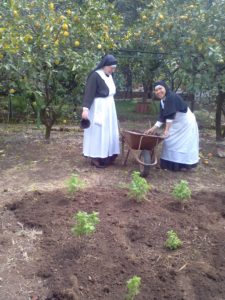Anamed international
Trough its publications and training seminars anamed enables communities and health centres in the Tropics to become more self-reliant in preventing and treating the most common diseases and health complaints.
In this way, in even the poorest communities, many lives have been saved, AIDS patients become strong and healthy, and health centres become less dependent on imported medicines.
In contrast …
A voice from the pharmaceutical
industry:
“We are not in business to save lives, but to earn money – saving lives is not our concern.”
An answer by Urs Flückiger, Director of Roche
South Korea when challenged to reduce the
price of AIDS drugs
Buko Pharma No. 8 October 2008
Continue reading →
Scientific name: Artemisia annua
Order/Family: Asterales: Asteraceae
Common names: Annual wormwood, Sweet wormwood

Artemisia annua anamed plants
Artemisia annua anamed
Artemisia annua is a crop for the production of anti-malarial and possibly antibacterial agents and natural pesticides. It was originally collected by the Chinese as a herbal medicine and is currently processed by pharmaceutical firms for the production of artemisinin for Artemisinin-based Combination Therapies (ACTs) in the treatment of malaria. (EcoPort). ACTs have been shown to have rapid resolution to fever and parasitaemia; low toxicity and are well tolerated. The artemisinin compounds are effective against Plasmodium falciparum and P. vivax, including multi-drug-resistant strains. Continue reading →
The Independent, 29 December 2004
By Meera Selva in Chencha, Ethiopia
Tibebu Orcho holds up a packet of seven plastic bags, each filled with a
finely ground, dark green leaf, and asks us to inhale its head-clearing
scent.
Artemisia annua, or sweet wormwood, has become his main source of
income, and a life-saver for his community. Artemisia is an ancient cure
for malaria; the Masai in Kenya used a variation of the plant, and the
Chinese have long known about its medicinal properties. Now farmers in
Ethiopia are discovering its virtues.
Mr Orcho grows artemisia in his idyllic garden, alongside apple trees
and rows of cabbages. Once the plant is ready to be harvested, he cuts
off the leaves, dries them and crumbles them up. He then fills plastic
bags, seals them with a candle and sells them to neighbours to be made
into tea. He tells them to pour one litre of boiling water over five
grams of dried leaves. If they have no scale, he tells them five grams
is the amount that just fits into a plastic 35mm film container.
“I used to buy these leaves, at 5 birr [30 pence] for a dose when my
children got malaria,” he said. “Then people from the community project
(run by Send a Cow) told me I could grow it myself. I was hesitant at
first, but I tried and it worked. Continue reading →
For once, an herbal remedy actually works. Why are malaria experts against it?
by Brendan Borrell

A man ride a bike and and distributes tea to workers on a flower farm.
Photos courtesy of Brendan Borrell
ENTEBBE, Uganda—It’s a little after 9 a.m. on the Wagagai Flower Farm, and Robert Watsusi pedals a bicycle laden with two 3-gallon jugs of a hot, bitter black tea. As he rounds a corner, workers emerge from football field–size growing houses to imbibe their weekly dose of the elixir they say keeps them free from malaria. “When I see people taking it, I feel happy,” says Watsusi. “It is very good for everyone.” Continue reading →
Anamed – Acion for Natural Medicine – was founded in 1986 in a jungle village in DR Congo by the pharmacist Dr. Hans-Martin Hirt and local healers, doctors and nurses with the aim of self-responsible health and nutritional care in the tropics.
In the preface of his book “Natural Medicine in the Tropics I” he says:
“During my six years of ‘apprenticeship’ in the African bush in DR Congo, Central Africa, I met thousands of people who never produced even a small bucket full of rubbish. Whatever survives them may serve as their gravestone, for example a tin mug. Twelve-years-old construct their own houses using natural materials and pangas only, huts which remain waterproof for years (…) Who among us would be able to build buffalo-traps, climb palm trees?
 Who among us has teeth free from caries without ever having seen a toothbrush or toothpaste?
Who among us has teeth free from caries without ever having seen a toothbrush or toothpaste?
Continue reading →



